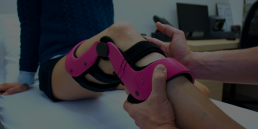Patellar syndrome, also known as “runner’s knee” or patellofemoral syndrome, is a condition that affects the knee joint and the patella. It can cause persistent pain and affect your ability to engage in your favourite daily and sports activities.
In this article, Laboratoire EVO explores patellar syndrome, its symptoms, diagnostic methods, and the different treatment approaches available, including the crucial role of orthotics in managing this condition.
I. Understanding the patellar syndrome
Patellar syndrome is a common condition affecting the knee joint and the patella. You need a brief anatomy and functioning lesson on the knee joint to understand this pathology!
Anatomy and functioning of the knee joint
The knee joint is a structure composed of several elements:
- the femur (thigh bone);
- the patella (bone located in front of the knee);
- the tibia (shin bone).
The quadriceps muscles, located in the front of the thigh, and the patellar tendon, which connects the patella to the tibia, play a crucial role in knee movement. This joint allows for flexion and extension movements, which are essential for walking, running, and other physical activities.
Mechanism of patellar syndrome
Patellar syndrome usually occurs due to repeated mechanical stress on the knee joint, often found in sports activities such as running. Repetitive movements, combined with poor positioning or insufficient quadriceps muscle strengthening, can lead to patellar irritation and patellofemoral pain.
II. Symptoms and diagnostic methods
The symptoms of patellar syndrome can vary in intensity and frequency among individuals. Nevertheless, some signs are characteristic of this condition.
Patellofemoral pain: an early sign of the patellar syndrome
Patellofemoral pain, felt in the front of the knee, is the first symptom of patellar syndrome. This pain is a burning or pulling sensation during knee flexion or extension. You may experience these pains, especially when going up or down stairs, running, or in prolonged sitting positions with bent knees. In advanced cases, the pain becomes persistent to the point of affecting daily activities like walking.
Diagnostic approaches: the importance of clinical examination
Health professionals can perform specific tests to evaluate knee joint mobility, quadriceps muscle strength, and pain upon palpating the patella and patellar tendon. Additional examinations, such as X-rays, MRI, or ultrasounds, may be prescribed to confirm the diagnosis.
III. Management of patellar syndrome
The treatment of patellar syndrome includes various approaches to relieve pain, promote healing, and restore joint function. Among these approaches, orthotics play a crucial role.
Role of knee orthosis in managing patellar syndrome
Knee braces are medical devices designed to support, stabilize, or correct biomechanical abnormalities of the knee joint. They reduce pressure on the patella for patellar syndrome by stabilizing the knee and promoting proper alignment. These devices are available in different forms, such as patellar support braces, biomechanical correction orthotics, and custom orthotics.
How do orthotics relieve pain and promote healing?
Orthotics work by redistributing forces exerted on the knee joint, reducing tension on the patella and surrounding structures. Allowing proper alignment of the knee and stabilization of the patella decreases friction and irritation, reducing pain and improving the healing of damaged tissues. At EVO, we provide custom and comfortable orthotics. We design them for your condition based on the type of activity you engage in, the frequency, and the environment in which you operate. In short, orthotics are 100% designed for your lifestyle!
Other therapeutic approaches
In addition to orthotics, you may also integrate other approaches:
- Physical therapy;
- Patellar taping;
- Stretching to improve muscle flexibility;
- Targeted quadriceps strengthening exercises;
- Activity modification is needed to avoid stressful movements for the knee joint.
These interventions can help strengthen surrounding muscles, improve joint stability, and reduce symptoms associated with patellar syndrome.
IV. Importance of early diagnosis and prevention
The benefits of early diagnosis
An early diagnosis, as we do at EVO, allows for quickly initiating appropriate treatment, reducing the progression of the disease, and preventing long-term complications. By promptly identifying with proactive intervention, we limit the impact of pain and improve your quality of life!
Prevention of patellar syndrome: good practices and advice
Preventing patellar syndrome also involves maintaining a healthy lifestyle! Keeping a healthy weight (through diet and sleep), warming up before physical activity, and performing physiotherapy and muscle-strengthening exercises at home are essential. It is also important to avoid prolonged positions that excessively stress the knee joint and consult a healthcare professional at the onset of abnormal symptoms.
Patellar syndrome: key takeaways
- Patellar syndrome affects the knee joint and can cause pain and limitations in daily and sports activities (especially running);
- Symptoms may vary, but patellofemoral pain is joint to each patient;
- Orthotics represent one of the best preventive treatments by relieving pain and promoting healing;
- Physical therapy, muscle strengthening exercises, and activity modification can help as complements;
- Thorough and early diagnosis is crucial for effective treatment and prevention of long-term complications;
- Maintaining a healthy weight, warming up before physical activity, and avoiding prolonged positions are good daily preventive practices;
Do you suffer from patellar syndrome? Contact our clinics for your diagnosis and learn more about our 100% custom knee brace!
Share this article
Related posts
December 6 2019
Orthosis for knee osteoarthritis treatment
April 14 2018
New Treatments Against Osteoarthritis
Unsteadiness, vertigo, persistent sensation of fall, these symptoms are often the cause...


